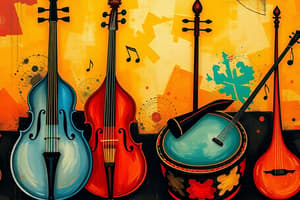Podcast
Questions and Answers
What is the primary material used for making the djembe's thin shell?
What is the primary material used for making the djembe's thin shell?
- Oakwood
- Tibba (correct)
- Bamboo
- Maplewood
How do didgeridoo players create vibrations to produce sound?
How do didgeridoo players create vibrations to produce sound?
- By blowing air at varying intensities (correct)
- By tapping on the instrument
- By using fingering holes
- By bowing the strings
What is a unique characteristic of cajons related to tuning their sound?
What is a unique characteristic of cajons related to tuning their sound?
- Different shell designs for tuning
- Adjustable flanges for tuning (correct)
- Metal keys for tuning
- Fingering holes for tuning
Which ancient harps lacked frets and relied solely on open strings tuned against each other?
Which ancient harps lacked frets and relied solely on open strings tuned against each other?
Which lyre type holds historical significance and symbolism related to Islam?
Which lyre type holds historical significance and symbolism related to Islam?
Which type of music refers to traditional Philippine folk songs played with stringed instruments?
Which type of music refers to traditional Philippine folk songs played with stringed instruments?
What is the main characteristic of Bukod Kuwintas?
What is the main characteristic of Bukod Kuwintas?
From which culture did Guitarra de Manila originate?
From which culture did Guitarra de Manila originate?
Which category does not belong to the three mentioned in the text?
Which category does not belong to the three mentioned in the text?
What is the significance of drumming in human cultures?
What is the significance of drumming in human cultures?
Study Notes
Instruments
In this exploration of musical instruments, we will delve into three specific categories: rondalla instruments, drum instruments, and lyre instruments. Each category has its own unique characteristics and history within various cultural contexts.
Rondalla Instruments
Rondalla music refers to traditional Philippine folk songs played with stringed instruments. These instruments come from different regions across the archipelago and have been passed down through generations. Some of the most common include:
Bukod Kuwintas
This is a two-stringed instrument made by tying wires around bamboo poles, which creates a simple yet powerful sound when plucked. It's often used in many types of Filipino dances such as Tinikling, Pandanggo, and Maglalatik.
Banjo de Manila
A four-stringed banjo originating from America, it was brought over by Spanish missionaries and became popular among Chinese communities living on Manila Bay during the late 18th century. This led to the development of distinct styles like Hokkien kuti and Teo Chew nyonya.
Guitarra de Manila
Another adaptation from American bluegrass culture, these six-string guitars were introduced to the Philippines alongside the banjos mentioned above. They are now staples in traditional rondalla ensembles throughout the country.
Drum Instruments
Drumming has always held a special place in human cultures due to its ability to convey emotional depth and energy through rhythmic patterns. Here are some notable examples:
Djembe
Originally from West Africa, the djembe is known for its versatile sounds ranging from deep bass notes to high-pitched slaps. Its design features a wide body and thin shell made of hardwood called 'tibba', while the skin covering the head can be goatskin, sheepskin, cowhide, or synthetic materials like Mylar.
Didgeridoo
Arguably one of Australia's oldest instruments dating back tens of thousands of years ago, didgeridoos are hollow logs drilled out using fire. Their smooth surface requires no fingering holes—instead, players create vibrations by blowing air into them at varying intensities.
Cajon
The cajón began as a box used to store clothing items before evolving into a percussive instrument primarily associated with Flamenco music. Today, they come in various shapes and sizes, often featuring adjustable flanges near the top and bottom edges allowing musicians to tune their sound more precisely.
Lyre Instruments
Lyres represent some of humanity's earliest attempts at creating melodies and harmonious sounds. While modern electro-acoustic and digital versions exist today, our focus here lies on ancient forms:
Celtic Harp
Also referred to as 'cláirseach' in Gaelic languages, harps were widely adopted across Europe after Roman times and eventually spread beyond the continent. With origins tracing back to prehistoric Ireland and Scotland, these early harps lacked frets; instead relying solely upon open strings tuned against each other to produce chords.
Ancient Greek Lyre
One of the primary musical instruments used in classical antiquity, particularly within religious rites dedicated to Apollo (the god of music), poetry, healing, justice, and light. These lyres typically consisted of multiple courses strung parallel to one another along a central axis.
Muhammadan Bilqis
Traditionally found among Muslim peoples who trace their lineage back to Muhammad Idris Al Makhdoum, this type of lyre possesses both historical significance and symbolism related to Islam. Made mostly from local materials such as wood, silk threads wound round iron wire for strings, and decorated horsehair fronds woven tightly together forming a small basket.
As you explore your passion for making beautiful music on various instruments, remember that every note resonates deeper than just auditory waves - they hold histories spanning continents and centuries!
Studying That Suits You
Use AI to generate personalized quizzes and flashcards to suit your learning preferences.
Description
Explore the rich history and unique characteristics of rondalla, drum, and lyre instruments from different cultural backgrounds. Learn about traditional Philippine folk instruments, versatile African drums, and ancient Greek and Celtic lyres.




